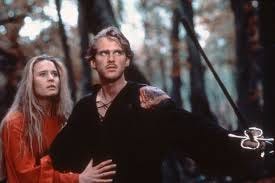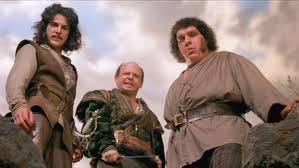Before I get to my post, I just wanted to share some news: My first webinar is next week: Three Must-Have Christmas Romance Tropes! It's on June 17, 2024, at 04:00 PM Pacific Time (US and Canada). Join me for an entertaining look at how to structure a Christmas romance with tropes. Plus, NYT Bestselling Romance Author Jennifer Probst will be joining me for a live Q&A, so bring your questions! Don’t worry; I’ll post a replay, too.
Register in advance now
The Princess Bride was an instant classic in 1987, and thirty-seven years later, it is still a fantasy romance. Unsurprisingly, fairy tales are trope-heavy; their survival is tied to relationships.
Magic, quests, and imaginative world-building are the hallmarks of fantasy romance. Entering another world quite different from the reader's daily life requires immersion in another experience—using senses, unfamiliar culture, and rules. Family, professions, politics, and workplace tropes help build a detailed world. The problems of the fantasy world are often life or death, so romantic suspense tropes such as blackmail, kidnap, revenge, secrets, suspects, and victims are key.
Fantasy romance shares the power of transformation; we see a lot of the ugly duckling trope here with the hero or heroine. Their quest causes them to grow into the person their love interest requires. Other popular tropes include hidden identities, disguises, and secrets galore.
Example: The Princess Bride (1987)
The story unfolds with the tale of a beautiful young woman (boss, virgin), Buttercup, and Wesley, the penniless farm boy (domestic staff, loner) who loves her (forced proximity). They fall in love, but Wesley leaves Buttercup to make his fortune for them (journey). After Wesley fails to return, Prince Humperdinck (alphahole, royalty) selects Buttercup as his bride (arranged marriage, fake relationship). Buttercup is confident Westley will return for her, yet he doesn't return (unrequited love). The night before her wedding to the prince, Buttercup is kidnapped by a trio of incompetent thieves hired by the neighboring kingdom (suspects).
The prince and a Mysterious Man in Black (loner) chase after the captured Buttercup (victim). The Man in Black bests the thieves to free Buttercup; he soon reveals himself as Wesley (hidden identity), a retired famous pirate (reunion). The couple escapes into a magical forest (journey), but the prince finds them.
Quick pause for a GMC for Buttercup, Wesley, and the prince.
Buttercup
Goal: Marry Wesley.
Motivation: True love.
Conflict: He leaves her to find his fortune, and Prince Humperdinck wants her to marry him.
Wesley
Goal: Stop Buttercup from marrying the prince and marry her himself.
Motivation: True love.
Conflict: He’s an outlaw pirate, and then he dies.
Prince Humperdinck
Goal: Marry Buttercup.
Motivation: He plans to have her murdered on their wedding night and give him a reason to invade the neighboring kingdom.
Conflict: She loves Wesley and refuses to marry him while he is alive.
Wesley and Buttercup escape into an enchanted forest, where they become lost (stranded) while evading dangerous creatures on their journey. Their reunion is short-lived before the prince recaptures them. The prince plans to have Buttercup murdered (secrets) on the eve of their royal wedding. By blaming her death on a neighboring kingdom, the prince plans to use it as an excuse to invade (politics, violence). But Buttercup promises to marry the prince if he lets Wesley go (unrequited love).
He promises, but after Buttercup is taken away, Wesley is tortured to death (violence) and dumped in the forest. He is rescued by Buttercup's kidnappers, who become friends. They take him to a mage (profession, family) couple who bring him back to life. Meanwhile, Buttercup's wedding feast approaches; she hopes Wesley will return but learns he has been killed. She plans to kill herself rather than be married to the prince when she discovers Wesley in her chamber. Wesley convinces the prince to surrender when he finds them. Buttercup and Wesley escape with their new friends and live happily ever after.
The Trope Thesaurus Six-Step Outline for Fantasy Romance:
1. Give each main character at least three person tropes as a base to build their character.
Princess Buttercup: Boss, royalty, victim.
Wesley: Disguise, profession, warrior.
2. Give each significant relationship in your story three change tropes to describe challenges in their relationship.
Kidnapped, mistaken identity, fake relationship.
3. Give each main character (including the antagonist) a meaningful and measurable goal.
Buttercup
Goal: Marry Wesley.
Wesley
Goal: Stop Buttercup from marrying the prince and marry her himself.
Prince Humperdinck
Goal: Marry Buttercup.
4. Make sure each main character has a motivation that describes why they are pursuing their goal. See if it alludes to a larger theme in your story. Examples: duty, revenge, power.
Buttercup
Goal: Marry Wesley.
Motivation: True love.
Wesley
Goal: Stop Buttercup from marrying the prince and marry her himself.
Motivation: True love.
Prince Humperdinck
Goal: Marry Buttercup.
Motivation: He plans to have her murdered on their wedding night and give him a reason to invade the neighboring kingdom.
5. Choose a conflict that will make it impossible for the main characters to achieve their goals. Examples include: bet/wager, blackmail, kidnapped, MacGuffin, secrets.
Buttercup
Goal: Marry Wesley.
Motivation: True love.
Conflict: He leaves her to find his fortune, and Prince Humperdinck wants her to marry him.
Wesley
Goal: Stop Buttercup from marrying the prince and marry her himself.
Motivation: True love.
Conflict: He’s an outlaw pirate, and then he dies.
Prince Humperdinck
Goal: Marry Buttercup.
Motivation: He plans to have her murdered on their wedding night and give him a reason to invade the neighboring kingdom (power).
Conflict: She loves Wesley and refuses to marry him while he is alive.
6. Develop your characters and setting with details such as world-building (descriptions, dialogue, and secrets).
The details are what make this fantasy romance a classic. Wesley's retellings of his life at sea as the Dread Pirate Roberts' valet are full of detail. How can we not get sucked into this story? What kind of pirate has a valet? Then when Wesley explains how he assumed the Dread Pirate Roberts identity, again, he gives us all sorts of deets. It's all relationships, baby!
When discussing fantasy world-building, we want a world we can be immersed in. The rodents of unusual size and quicksand found in the dangerous forest are great examples of details that transport us. Wesley's time on the torture rack and his recovery at the hands of the wizards gives us more elements of the story.
Secrets in this story lend motivation to the characters. As the Dread Pirate Roberts, Wesley bests Vizzini, the bandit leader, in a battle of wits involving poison by secret preparations. The prince’s secret plan to kill Buttercup on their wedding night and blame it on the neighboring kingdom motivates his actions.
There’s a terrific use of the ugly duckling trope as Wesley transforms from a poor farm boy to the Dread Pirate Roberts. Another significant change is through the reunion trope. After Wesley dies on the torture rack, a couple of bickering wizards bring him back to life because of his love for Buttercup.
The charm of Princess Bride is that it twists the tropes with humor and exaggeration. The physical feats of the brute squad, the oversized Prince Humperdink crown, and the torture rack that Wesley endures are all examples of how we are delighted and engaged by the details of this world. It’s what stories are meant to do!
What’s your favorite line, character, or scene in The Princess Bride? Let me know in the comments below!






What's impressive is that there are so many scenes and quotes to choose from. But if I had to choose one:
Vizzini: Inconceivable!
Montoya: You keep using that word. I do not think it means what you think it means.
Offscreen, I love the story about when Andre the Giant passed out drunk in the hotel lobby. He was too big to move so the hotel staff just cordoned him off with velvet ropes.